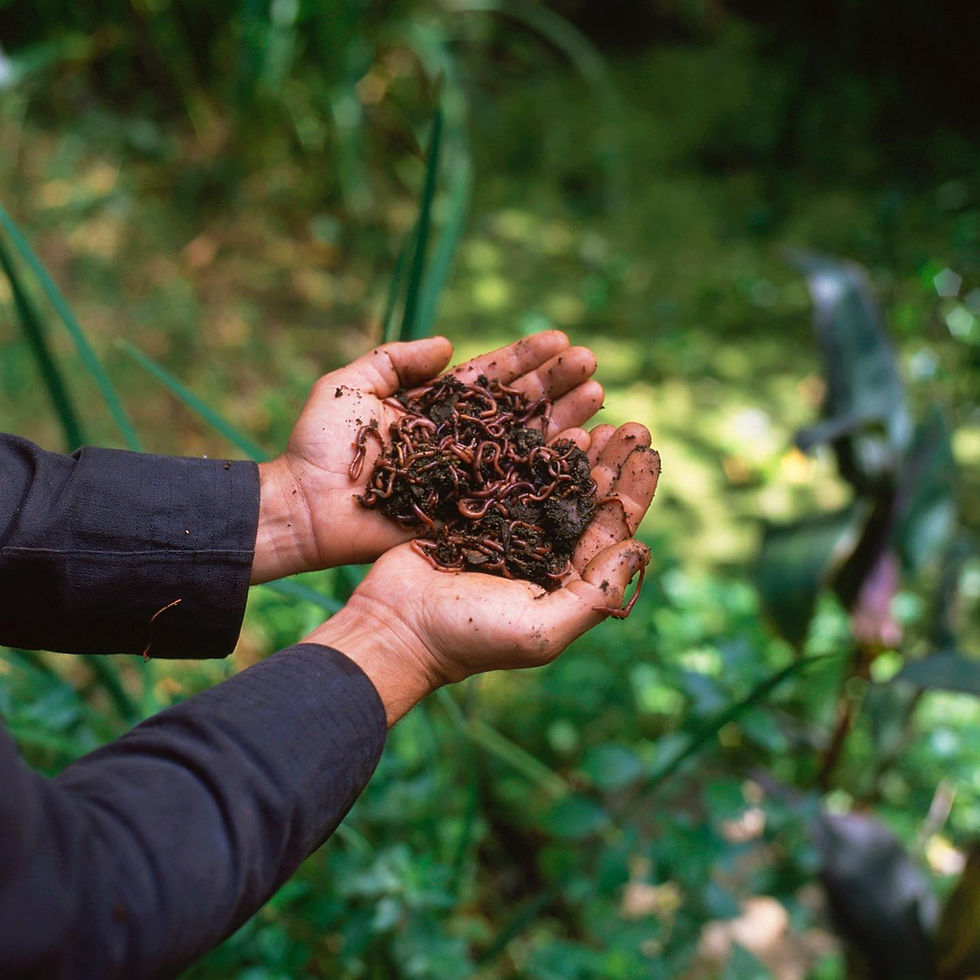Soil Regeneration at Terra Alta
- Valentina Delconte

- Aug 1
- 3 min read
Celebrating life underground
As the Celtic festival of Lammas arrived on the 1st day of August, we’re reminded that our journey into permaculture design begins with gratitude—for the Earth, for People and for the very foundation of it all: the soil.
Soil is a living, dynamic ecosystem that supports plants, animals, and microbial life. They’re not just “dirt”—it’s an intricate web of life and nutrients that sustains everything above ground with its life and structure.
A healthy underground ecosystem is balanced and capable of regenerating itself. Dark and humus-rich soils in the garden support our crops, water cycles, biodiversity, and carbon sequestration. And it’s what brings the abundance flowing through our gardens, our kitchen and the Terra Alta community.

In this season, we honour our garden soil by transforming its fruits — tomatoes, aubergines, sweet corn, and zucchini to mention a few — into nutritious meals feeding plenty of people.
And just as we nourish our bodies and souls, we’re also cultivating knowledge, stewardship and connection with the land—key elements of what we call regeneration.
Permaculture and Regenerative Agriculture
Regeneration is more than a goal—it's a systems design approach that integrates agriculture, water, energy, economy, and the inner and social dimensions of life.
Both approaches aim to restore ecosystems, and while regenerative agriculture focuses on agricultural practices like no-till, holistic grazing, and cover cropping, permaculture tags along with ecosystem-level approaches.
Regenerative agriculture is the production of food and fiber from the biological life of the world’s land and waters through managing simultaneously the indivisible complexity of human organizations, economy, and nature to sustain all businesses, economies, and civilization.” - the Savory Institute
Both movements reimagines how we live, work, and relate to the Earth—offering holistic solutions that feed both planet and people.

The first step: Regenerating the Soil
Soil is where it all starts. At Terra Alta, we've spent years regenerating degraded, compacted earth into living, breathing ecosystems full of microbial life.
“It might be hard to believe but I invested more in building soil then what my family house, a pretty comfortable one. Soil is gold, and I hope my daughters one day recognize that” - Pedro Valsdjiu, co-founder of Terra Alta and permaculture teacher
So over the years, we collected and refined a series of soil regenerating methods which include:
Combined composting systems, such as compost heaps, hot composting, and moisture-retaining mulch to create the ideal physical and chemical conditions for underground life.
Organic, home-brewed fertilizers based on locally-harvested chicken manure and fermented bioaccumulator plant species, both really nutritious treats;
Harvesting and inoculating indigenous microorganism communities from the healthy forest soil through traditional Korean Farming techniques;
No-tilling and minimal soil disturbance when preparing the beds, for instance, using the broad forks and thilther.
Photos by Valentina Busnelli
A few years ago, Pedro designed, tested, and successfully implemented vermi-permanent beds, permanent garden beds enriched with red tiger worm nests on one end. By placing smaller composting stations in the middle (inside terracotta pots), our composting heroes actively travel along the bed, attracted by fresher organic materials, creating nutrient-rich and well-structured soil along the way.
Water, Soil & Climate—A Connected System
The farm has been designed with the land’s topography to slow water, prevent erosion, and nourish plants deeply. Features like swales, terraces, and perennial forest gardens help create resilient microclimates and strengthen the soil food web.
Our chicken systems contribute too—grazing, fertilizing, and cycling nutrients in a closed-loop model.
Water, soil, and climate are treated as interconnected, with each element influencing the others to create resilient microclimates. The permaculture-based rdesign aims for a closed-loop system where all elements and functions reinforce one another.
By integrating smart water management, perennial plant systems like the forest gardens, and an active animal ecosystem, we’ve created a self-sustaining design that supports soil regeneration. Each element—from swales to chickens—works in harmony to build a resilient, thriving landscape.

Regeneration Is a Journey
As the wheel of the year turns to Lammas on 1st of August, we reflect on the efforts and contributions in regenerating our soil, now so rich and teeming with life, by all members of the Terra Alta community - past and current faciltators, volunteers, students and teachers. We also renew our intentions to further nurture what nurtures us, continuing to deepen our knowledge about the universe beneath our feet.










Comments